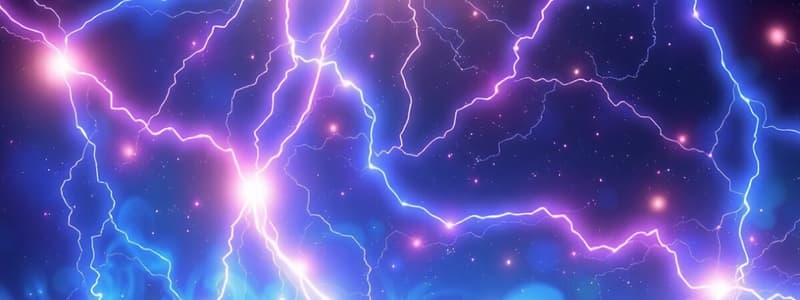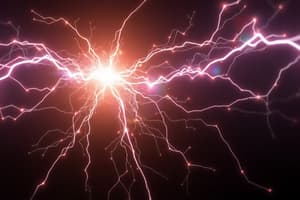Podcast
Questions and Answers
What fundamental property of matter causes it to experience force in an electromagnetic field?
What fundamental property of matter causes it to experience force in an electromagnetic field?
- Density
- Mass
- Volume
- Electric Charge (correct)
If two negatively charged objects are placed near each other, what type of force will they experience?
If two negatively charged objects are placed near each other, what type of force will they experience?
- Gravitational
- Neutral
- Attractive
- Repulsive (correct)
What is the SI unit of electric charge?
What is the SI unit of electric charge?
- Volt
- Ampere
- Ohm
- Coulomb (correct)
Which of the following statements is consistent with the principle of charge conservation?
Which of the following statements is consistent with the principle of charge conservation?
The elementary charge, denoted by e, is the magnitude of the charge carried by a single proton or electron. What is its approximate value?
The elementary charge, denoted by e, is the magnitude of the charge carried by a single proton or electron. What is its approximate value?
What does the density of electric field lines indicate?
What does the density of electric field lines indicate?
What is the SI unit of electric field strength?
What is the SI unit of electric field strength?
A positive test charge is placed in an electric field. Which direction will the force from the electric field act?
A positive test charge is placed in an electric field. Which direction will the force from the electric field act?
What is electric potential also commonly referred to as?
What is electric potential also commonly referred to as?
What are surfaces called where the electric potential is constant?
What are surfaces called where the electric potential is constant?
What property of a capacitor measures its ability to store electric charge?
What property of a capacitor measures its ability to store electric charge?
An uncharged capacitor is connected to a voltage source. What increases as the charging process continues?
An uncharged capacitor is connected to a voltage source. What increases as the charging process continues?
What quantity is defined as the rate of flow of electric charge through a conductor?
What quantity is defined as the rate of flow of electric charge through a conductor?
Which of the following is a correct statement of Ohm’s Law?
Which of the following is a correct statement of Ohm’s Law?
What produces a magnetic field?
What produces a magnetic field?
Which of the following is true about magnetic field lines?
Which of the following is true about magnetic field lines?
What is the fundamental interaction between electric and magnetic fields called?
What is the fundamental interaction between electric and magnetic fields called?
Which of the following describes the process by which a changing magnetic field induces a voltage in a circuit?
Which of the following describes the process by which a changing magnetic field induces a voltage in a circuit?
Which law states that the direction of the induced current opposes the change in magnetic flux that produces it?
Which law states that the direction of the induced current opposes the change in magnetic flux that produces it?
What set of equations describes the behavior of electric and magnetic fields and their interactions?
What set of equations describes the behavior of electric and magnetic fields and their interactions?
Flashcards
Electromagnetism
Electromagnetism
A fundamental force of nature that governs interactions between charged particles and manifests as electric and magnetic fields.
Electric Charge
Electric Charge
A fundamental property of matter causing it to experience force in an electromagnetic field.
Elementary Charge (e)
Elementary Charge (e)
The magnitude of charge carried by a single proton or electron, approximately 1.602 x 10^-19 C.
Electric Field
Electric Field
Signup and view all the flashcards
Electric Potential (Voltage)
Electric Potential (Voltage)
Signup and view all the flashcards
Capacitance
Capacitance
Signup and view all the flashcards
Electric Current
Electric Current
Signup and view all the flashcards
Resistance
Resistance
Signup and view all the flashcards
Magnetic Field
Magnetic Field
Signup and view all the flashcards
Electromagnetism
Electromagnetism
Signup and view all the flashcards
Electromagnetic Waves
Electromagnetic Waves
Signup and view all the flashcards
Electromagnetic Induction
Electromagnetic Induction
Signup and view all the flashcards
Inductance
Inductance
Signup and view all the flashcards
Maxwell's Equations
Maxwell's Equations
Signup and view all the flashcards
Gauss's Law for Electricity
Gauss's Law for Electricity
Signup and view all the flashcards
Gauss's Law for Magnetism
Gauss's Law for Magnetism
Signup and view all the flashcards
Faraday's Law of Induction
Faraday's Law of Induction
Signup and view all the flashcards
Ampère-Maxwell's Law
Ampère-Maxwell's Law
Signup and view all the flashcards
Study Notes
- Electromagnetism is one of the four fundamental forces of nature.
- The electromagnetic force is responsible for the interactions between charged particles.
- It manifests as electric and magnetic fields.
- Electromagnetism underlies many phenomena, including light, radio waves, and electrical devices.
Electric Charge
- Electric charge is a property of matter that causes it to experience a force when placed in an electromagnetic field.
- Two types of electric charge exist: positive and negative.
- Like charges repel, and opposite charges attract.
- The SI unit of electric charge is the coulomb (C).
- The elementary charge (e) is the magnitude of the charge carried by a single proton or electron, approximately 1.602 x 10^-19 C.
- Charge is conserved in a closed system, meaning the total charge remains constant.
- Charge is quantized, existing in integer multiples of the elementary charge (e).
Electric Field
- An electric field is a vector field that exists in the space surrounding an electric charge.
- It exerts a force on any other charged particle within the field.
- The electric field (E) at a point is defined as the electric force (F) per unit positive test charge (q₀): E = F/ q₀.
- The SI unit of the electric field is newtons per coulomb (N/C) or volts per meter (V/m).
- Electric field lines visualize electric fields, indicating the force direction on a positive test charge.
- Electric field lines originate from positive charges and terminate on negative charges.
- The density of field lines is proportional to the strength of the electric field.
- For a point charge q, the electric field at a distance r is given by Coulomb's law: E = k q/ r², where k is Coulomb's constant (approximately 8.9875 x 10^9 N⋅m²/C²).
Electric Potential
- Electric potential (voltage) is the electric potential energy per unit charge at a specific location in an electric field.
- It is a scalar quantity, measured in volts (V).
- The potential difference between two points is the work required to move a unit positive charge from one point to the other.
- Electric potential energy is the potential energy of a charged particle in an electric field, equal to the charge multiplied by the electric potential.
- Equipotential surfaces are surfaces where the electric potential is constant; no work is required to move a charge along such a surface.
Capacitance
- Capacitance measures a capacitor's ability to store electric charge.
- A capacitor consists of two conductive plates separated by an insulating material (dielectric).
- Capacitance (C) is defined as the ratio of the charge (Q) stored on the capacitor to the voltage (V) across it: C = Q/ V.
- The SI unit of capacitance is the farad (F).
- The energy stored in a capacitor is U = (1/2) C V².
- For a parallel-plate capacitor with plate area A and separation d, the capacitance is C = ε₀ A/ d, where ε₀ is the permittivity of free space (approximately 8.854 x 10^-12 F/m).
- Dielectric materials increase capacitance by reducing the electric field for the same charge.
Electric Current
- Electric current is the rate of flow of electric charge through a conductor.
- It is defined as the amount of charge (Q) passing a point per unit time (t): I = Q/ t.
- The SI unit of electric current is the ampere (A).
- Conventional current is the direction of positive charge flow, opposite to the direction of electron flow.
- Ohm's law states that the current (I) through a conductor is directly proportional to the voltage (V) and inversely proportional to the resistance (R): V = I R.
- Resistance (R) measures a material's opposition to current flow and is measured in ohms (Ω).
- Resistivity (ρ) is an intrinsic property that quantifies how strongly a material opposes electric current; Resistance is proportional to resistivity and length, and inversely proportional to cross-sectional area.
Magnetic Field
- A magnetic field is a vector field that exerts a force on moving electric charges and magnetic materials.
- Magnetic fields are produced by moving electric charges or intrinsic magnetic moments of elementary particles.
- The SI unit of magnetic field is the tesla (T).
- Magnetic field lines visualize magnetic fields, indicating the force direction on a moving positive charge.
- Magnetic field lines form closed loops, unlike electric field lines.
- Permanent magnets produce magnetic fields due to the alignment of atomic magnetic dipole moments.
- The magnetic force on a moving charge q with velocity v in a magnetic field B is given by the Lorentz force: F = q (v x B).
Electromagnetism
- Electromagnetism is the interaction between electric and magnetic fields.
- Moving electric charges create magnetic fields.
- Changing magnetic fields create electric fields (electromagnetic induction).
- The relationship between electricity and magnetism is described by Maxwell's equations.
- Maxwell's equations form the foundation of classical electromagnetism.
- Electromagnetic waves are disturbances in electric and magnetic fields that propagate through space, carrying energy.
- Radio waves, microwaves, infrared radiation, visible light, ultraviolet radiation, X-rays, and gamma rays are examples of electromagnetic waves.
- Electromagnetic induction is the process by which a changing magnetic field induces a voltage (electromotive force) in a circuit.
- Faraday's law of induction states that the induced electromotive force (EMF) in any closed circuit equals the negative of the time rate of change of the magnetic flux through the circuit.
- Lenz's law states that the direction of the induced current opposes the change in magnetic flux that produces it.
Inductance
- Inductance is the property of a circuit element to oppose changes in current.
- An inductor typically consists of a coil of wire.
- Changing the current through an inductor induces a voltage across it.
- Inductance (L) is defined as the ratio of the magnetic flux linkage to the current (I): L = Φ/ I.
- The SI unit of inductance is the henry (H).
- The energy stored in an inductor is given by U = (1/2) L I².
Maxwell's Equations
- Maxwell's equations describe the behavior of electric and magnetic fields and their interactions.
- Gauss's law for electricity relates the electric field to the distribution of electric charge.
- Gauss's law for magnetism states that there are no magnetic monopoles.
- Faraday's law of induction describes how a changing magnetic field creates an electric field.
- Ampère-Maxwell's law describes how a magnetic field is generated by both electric current and a changing electric field.
- Maxwell's equations predict the existence of electromagnetic waves and determine the speed of light.
Studying That Suits You
Use AI to generate personalized quizzes and flashcards to suit your learning preferences.




